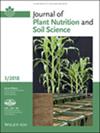Development of an express method for measuring soil nitrate, phosphate, potassium, and pH for future in-field application
Abstract
Background
In practical farming, there is often a need for short-term availability of information on the soil nutrient status.
Aims
To develop a new express method for the extraction of major plant-available nutrients and measurement of soil nutrients. In future, this method shall serve for in-field measurements of soil samples with an ion-sensitive field-effect transistor (ISFET).
Methods
Various extraction conditions such as type of extractant, soil-to-solution ratio, time, and intensity were investigated on a broad selection of dried soil samples in the laboratory. Based on 83 field-moist soil samples with varying clay contents, these conditions were compared to standard laboratory methods.
Results
With increasing extraction time, the nutrient concentrations increased. When the soil-to-solution ratio was reduced, a greater share of nutrients was extracted, independent of soil type. H2O and 0.01 M CaCl2 and standard calcium-acetate-lactate (CAL) solution proved to be too weak in the short period to reach the ISFET sensor measurement range. Higher concentrated CAL solutions performed much better. Finally, a 5-min CaCl2 extraction followed by the removal of an aliquot for the determination of soil pH and NO3− was found to be effective. The remaining solution was then mixed with 0.20 M CAL solution for the analysis of H2PO4− and K+ at 10 min of extra extraction time. This extraction method showed very good correlations with the values based on the German laboratory reference methods for pH (R2 = 0.91) and for nitrate (R2 = 0.95). For phosphorus and potassium, we obtained an R2 of 0.70 and 0.81, respectively, for all soils. When soils were grouped according to clay content higher correlations were found.
Conclusions
A new express method based on a wet-chemical approach with a soil preparation procedure was successfully developed and validated. This seems to be a valuable basis for future in-field measurements via ISFET.


 求助内容:
求助内容: 应助结果提醒方式:
应助结果提醒方式:


